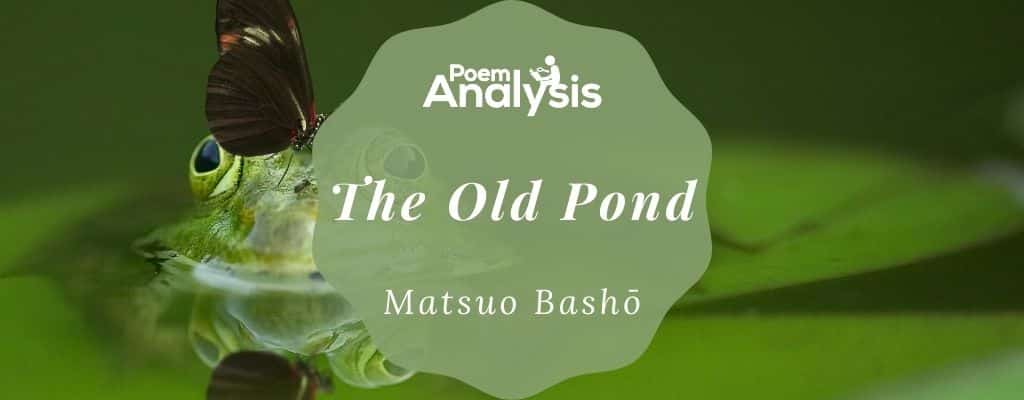Matsuo Bashō, the poet of this haiku, was a famous poet of the Edo period in Japan. He is recognized as the greatest master of haiku or hokku. In ‘The Old Pond,’ also known as ‘The Ancient Pond,’ Bashō plays with the sound of the frog leaping in the old pond and imagery of that ancient place.
The Old Pond Matsuo BashōOld pond...a frog jumps inwater's sound
In traditional Japanese, the haiku reads:
Furu ike ya
kawazu tobikomu
mizu no oto
With the Japanese characters being:
古池や 蛙飛び込む 水の音
The literal translation of the words of this haiku poem, by Robert Hass, is:
Old pond…
a frog jumps in
water’s sound
However, there is nothing specific about the context or the development of poetic thoughts. One has to take resort to the imagination to get into the core of this poem.
Summary of The Old Pond
In this haiku poem, there are only three images. One is a static image of an old pond. The second one is a dynamic image of a frog jumping into the pond. Lastly, there is an auditory image that presents the sound that is generated from a frog jumping into the pond-water. While reading the haiku, one has to be imaginative to get to the core of the poem. To begin with, the pond in the poem is an old water body. It seems people have either abandoned the pond or it is there for a long time. Thereafter, the frog that jumps into the pond presents two things, the season and the reason for its jumping. Lastly, the water’s sound creates a resonance in a reader’s mind. This sound has some deeper meaning that is discussed in the latter part of the analysis.
Meaning
This haiku contains manifold meaning inside its brevity and compactness. To begin with, the literal meaning of the Japanese text is of great importance. As it gives the key to the inner meaning of the text. In the first phrase, “Furu” means old, and “ike” means pond. Here, “ya” is a “kireji” or “cutting word”. Thereafter, in the second phrase, “kawazu” means frog, and “tobikomu” means “jumping into.” In the last phrase, “mizu” means water, and “oto” stands for sound. Here, “no” is a phoneme or an “On.” In Japanese, “On” stands for “sound.” In this way, the literal meaning of the text, in Standard English, is “Old pond—frog jumping into—water’s sound.”
Structure
‘The Old Pond’ consists of a total of 17 syllables. In the first phrase, there are 5 syllables and in the second phrase, there are 7 syllables. The last phrase has 5 syllables. Structurally, a haiku poem has a “kireji” or cutting word. Here, the cutting word is in the first phrase. It is “ya” that marks a shift in the poem. Another important element of a haiku is “kigo.” “Kigo” means a word or phrase associated with a particular season, used in traditional forms of Japanese poetry. In this haiku, the “kigo” is the “frog.” Generally, in Asia, the frog is associated with the Monsoon season. But, here, as Bashō portrays the scene, there are no sounds except that of the water. So, the kigo in this poem refers to the Spring season.
Literary Devices
There are some important literary devices in this haiku poem. Firstly, the “pond” is a metaphor for the subconscious mind. It can also be a metaphorical reference to the soul. Whereas, the “old pond” seems to be an example of personification. Here, Bashō personifies the pond. Thereafter, in the second phrase, the frog acts as a metaphor. Here, it embodies any external stimulus that incites the human mind to think. Lastly, the “water’s sound” contains an onomatopoeia. The poet uses the sound to portray an image. Moreover, there is also metonymy in this phrase. Here, the poet presents the effect to refer to the cause.
Analysis of The Old Pond
Line 1
The old pond-
The haiku, using Fumiko Saisho’s translation, begins with the image of the old pond. It can be somewhere in a forest or far from human habitation. Bashō associates no other sound with this image. So, the pond is probably at a distance, in tranquility and silence. Moreover, it is old. Being an ancient creature, it has survived the ravages of time. Burdened with the experience of the long years, the pond exists as a sage. The poet somehow connects himself with this pond. There is a closeness in their nature. Both are silent and at peace.
The old pond seems to be a symbol of the subconscious mind. It is there inside everyone. Like the old pond, it exists in silence. Moreover, the poet refers to the subconscious mind of an old person. Here, the old man is undoubtedly the poet himself.
Line 2
a frog jumps in,
Suddenly a frog breaks the tranquility of the pond. It doesn’t start to croak in its usual pattern. The frog simply jumps into the pond. Why does the frog jump into the pond? One has to ask this question first before moving to the climax of this haiku. The frog might have jumped into the pond, not for breeding or laying eggs as it’s not the season of monsoon. So, one thing is clear the frog does it for its biological instinct. It seems as if the water of the pond rejuvenates the frog. So, it jumps into the pond naturally without any biological urge or chemical upsurge inside its body. Like the frog, a person also needs solace to give time to his mind and soul. Thus, the frog jumping into the water can be a symbolic reference to meditation.
Line 3
sound of the water.
In the last line of the haiku, the sound becomes an interesting part of the imagery. The sound is not artificial. An external stimulus is responsible for the creation of sound. When the frog jumps into the water, it generates a short-staying sound. It isn’t shrill. Yet it’s not deep. The texture of the water’s sound lies somewhere in the middle. The poet’s mind gets alert after hearing the song but it doesn’t break his concentration. Rather it heightens his trance and takes him to the next level. One can think about it differently.
While cooking a very special dish, one has to use every material in a specific amount. If anything goes beyond its certain concentration, the dish doesn’t taste good. The opposite is also true. Here, in this haiku, the sound of the water is that special ingredient that must be used in a sound amount. Thus, it can heighten the level of the poet’s mediation.
Similar Poetry
Like Bashō’s ‘The Old Pond,’ here is a list of poems in which the poets explore more by saying less.
- Fame is a bee by Emily Dickinson – It’s one of the best Emily Dickinson poems. This poem discusses the nature of fame.
- Time Is by Henry van Dyke – This poem presents the definition of time that varies from person to person.
- Their Sex Life by A. R. Ammons – This poem contains only two lines but it is wide in its poetic range.
- Pomegranates by Sin Hum – This poem is written in sijo, a Korean poetic form that originated in the Goryeo period. It seems to have been written in haiku.
You can read about 10 of the Best Haikus to Read here.





This haiku–like almost all of Bashō’s–captures the very moment of satori, in Zen Buddhism a sudden moment of clarity, of awakening, of enlightenment. And I’m always astonished at how well this translates into English.
Absolutely, John, your insight is spot on. Basho has this extraordinary gift for bottling the essence of a fleeting epiphany within the concise form of haiku. It’s as if, in those sparse lines, he distills the entire universe into a drop of experience — and it’s remarkable. The translation of his work into English preserves that delicate balance of simplicity and depth, doesn’t it? It’s fascinating how his choice of the every day — the croak of a frog, a silent pond — resonates across cultures, transcending language. They’re like small stones thrown into the still waters of our minds, their ripples inviting us into a moment of profound connection and clarity. And yes, the satori element is truly compelling. In the Zen tradition, such instantaneous awakening is both the path and the destination, and Basho crafts this journey masterfully in his poetry. His work isn’t just art; it’s a… Read more »
Can I like get “inspired” by this analysis of the old pond poem? need this for school
umm, can you?